What Is Ecommerce Marketing?
Ecommerce marketing uses promotional tactics to attract new customers to your store, convert them into paying customers, and encourage them to return for future purchases to increase retention.
Ecommerce marketers use many channels to attract website visitors, including email and social media marketing, search engine optimization (SEO), and pay-per-click (PPC).
For example, a clothing store might promote a Fourth of July sale through an email campaign to its customer and subscriber lists. They could then retarget those audiences through Facebook Ads to improve conversion rates.
A multichannel strategy allows ecommerce marketers to reach a wider audience and drive as much traffic as possible to their online stores. That creates a seamless customer experience across all paid and organic channels.
Ecommerce Marketing vs Ecommerce Advertising
Ecommerce advertising is a subset of ecommerce marketing.
Ecommerce marketing includes product promotion strategies and tactics
Ecommerce advertising refers to paid product promotion on digital advertising platforms. For example, display, banner, or rich media ads.
Ecommerce advertising is part of a holistic multichannel marketing strategy, which considers all aspects of the customer journey.
This approach aligns marketing channels like social media, email, SEO, and advertising to create a consistent and integrated experience.
Types of Ecommerce Marketing
Ecommerce marketing encompasses a wide range of channels like:
- Content
- SEO
- Social media
- PPC
- Local
Email is a tried-and-true ecommerce marketing tool. It drives an average ROI (return on investment) of $36 for every dollar spent. That’s higher than any other channel.
Marketers use email marketing to promote products or services, connect with customers, motivate purchases, and encourage retention across the customer journey.

For example, & Other Stories, a fashion brand, uses email marketing to promote new styles, share inspiring stories to engage their subscribers, and offer exclusive deals and promotions.
You can set up a reliable campaign quickly with email service providers like Intercom, ActiveCampaign, and ConvertKit.
Content Marketing
Marketers use content marketing to attract and retain a specific audience by producing valuable and relevant content, establishing topical authority, and driving qualified leads to stores.
“Content” can take the form of blog posts, white papers, case studies, videos, podcasts, downloadable templates, and more.
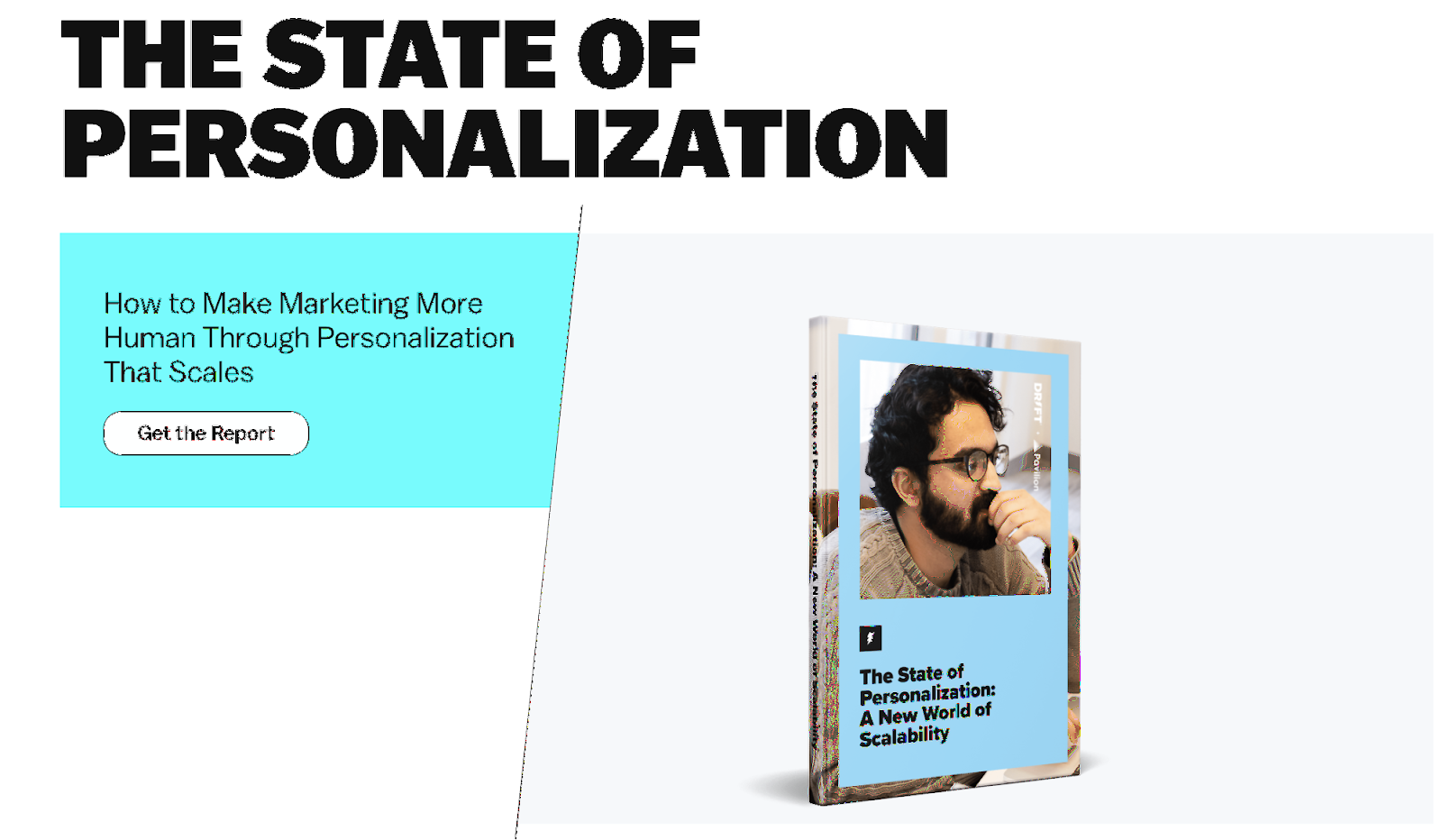
Given the many content types available, you need a concrete strategy for each one.
Once you have a content marketing strategy, tools like Semrush’s Topic Research tool, Keyword Gap Analysis, and On Page SEO Checker can help you find ideas, identify gaps with competitors, audit existing content, and track performance.
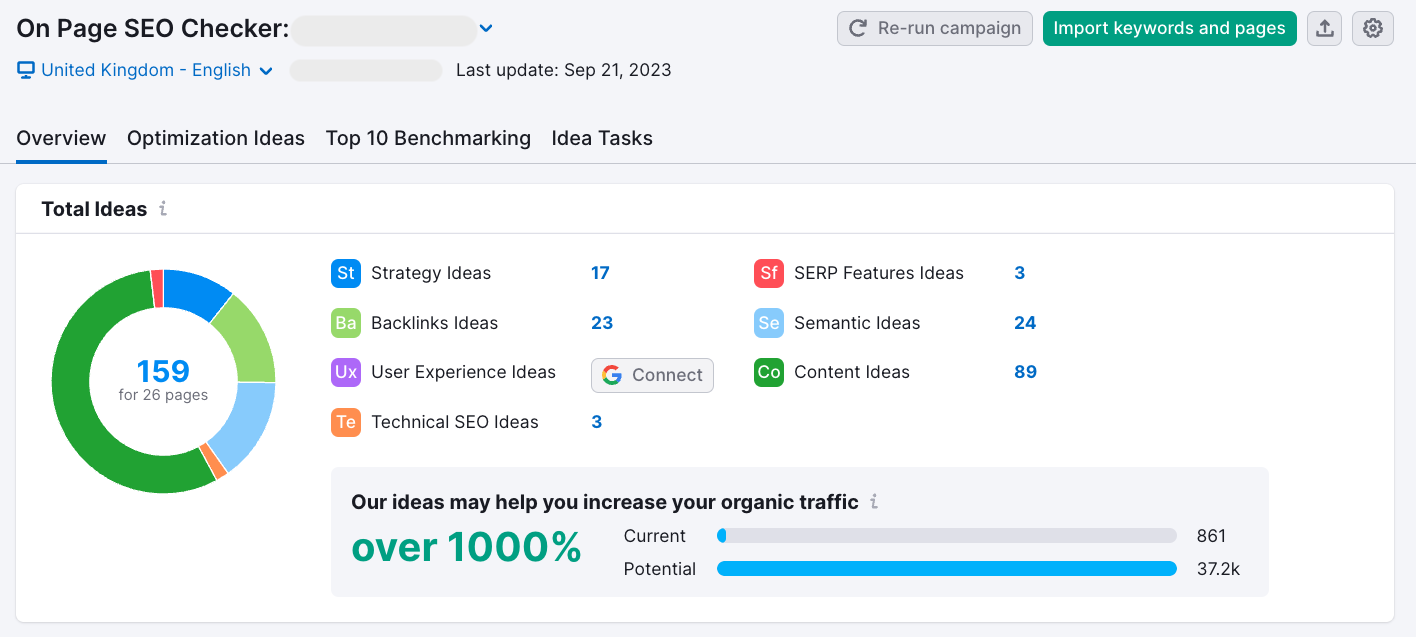
Learn more about how marketers use content marketing strategies in our State of Content Marketing: 2023 Global Report.
Search Engine Optimization (SEO)
Ecommerce SEO improves your site’s visibility and search engine rankings to drive sustainable organic traffic to your store.
That includes optimizing product pages, category pages, meta tags, building high-quality backlinks, and creating quality content.
The foundation of any SEO strategy is a solid understanding of which search terms—or keywords—your target audience is using to find the products you offer.
For example, suppose you sell artisanal teas, and someone in your area searches for “buy artisanal tea brands” on Google. In that case, if your store is optimized for the term, it may appear first in the SERP (search engine results page), increasing the likelihood of a user clicking through to your website and potentially making a purchase.
Using Semrush’s Keyword Magic Tool, you can identify your target keywords and begin implementing SEO strategies that have long-term business benefits.
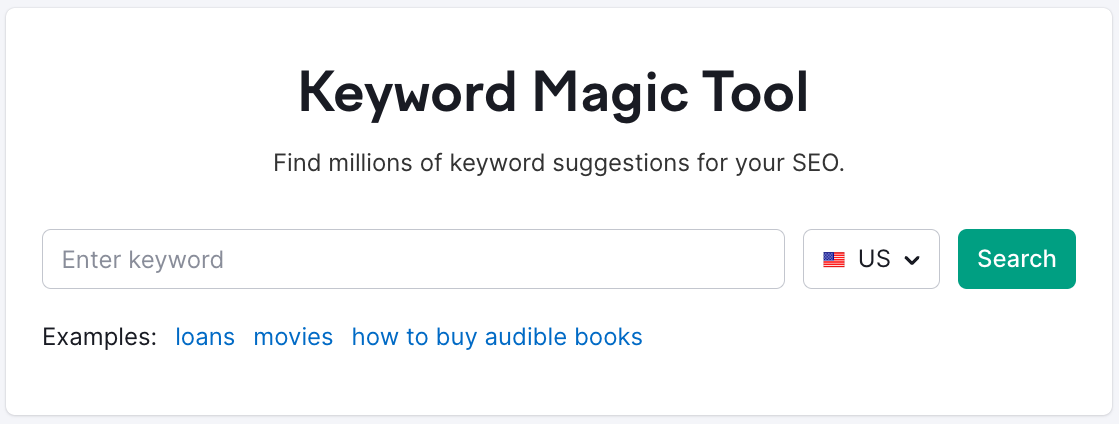
Social Media
Social media marketing uses platforms like Instagram, Facebook, and LinkedIn to promote a brand, product, or service, build customer relationships, and drive ecommerce site traffic or sales.
Social media marketing includes tactics like:
- Creating and sharing content
- Competitor analysis
- Follower engagement
- Partnering with influencers
- Analyzing metrics to improve performance
Some ecommerce brands use social media marketing to promote their mission. Tentree, a clothing company, leans into its message through social media posts.

Although this post doesn’t promote Tentree’s products, it highlights its eco-friendly mission, which can attract and engage its socially conscious target audience.
Semrush’s Social Media Dashboard allows you to run competitor analysis, create and plan content, and track messages and performance through analytical insights.
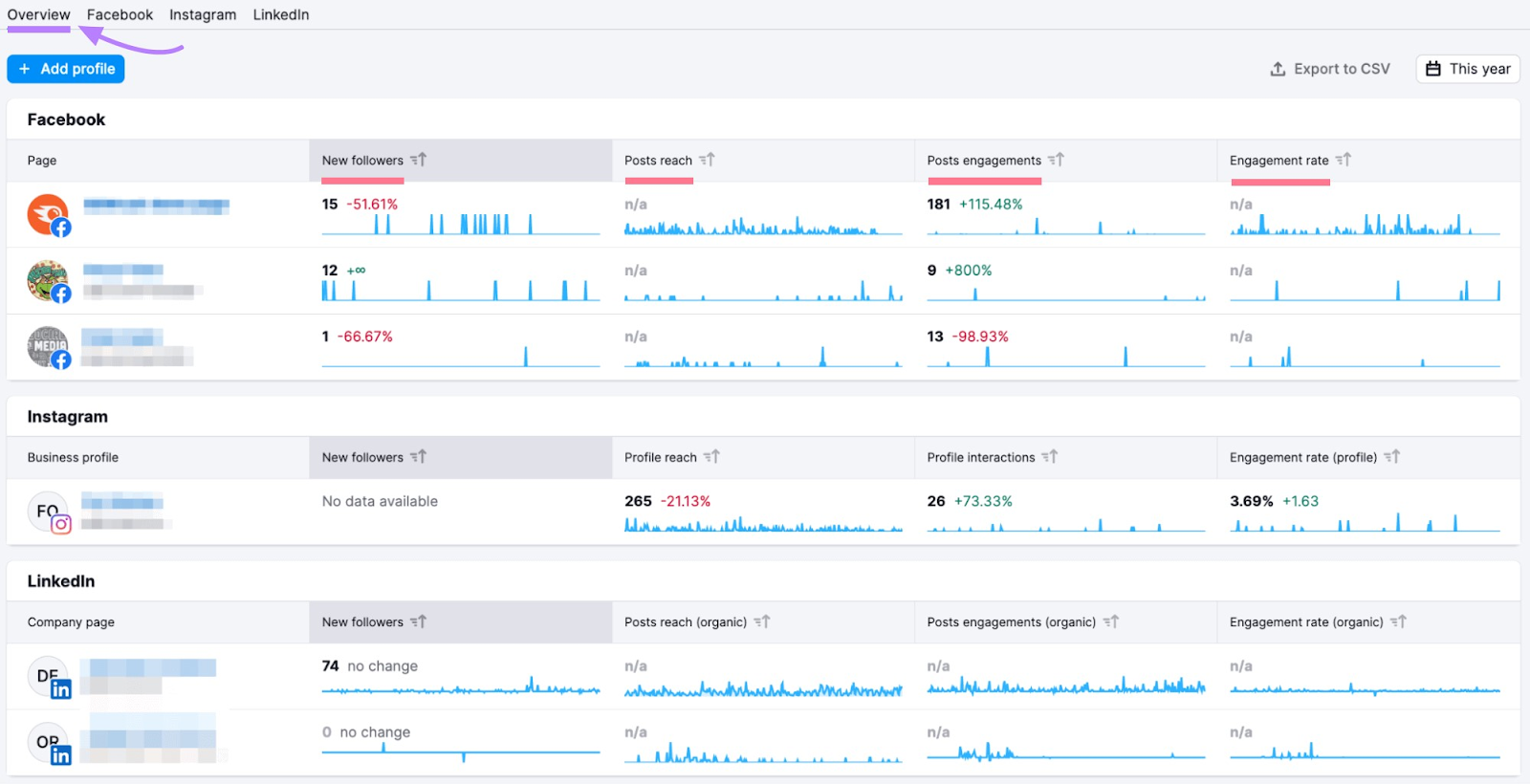
Pay-Per-Click (PPC)
Advertisers who use this method pay each time a user clicks on one of their ads displayed on search engines or social media platforms.
Ecommerce businesses use PPC ads to drive traffic to their website while using PPC platforms to target specific customer demographics.
Google Ads is one of the most popular PPC ad platforms. It enables ecommerce businesses to create paid search ads related to their products or services that appear on the SERPs.
When people search for a keyword like “best microwave,” many sponsored text and shopping ads appear:
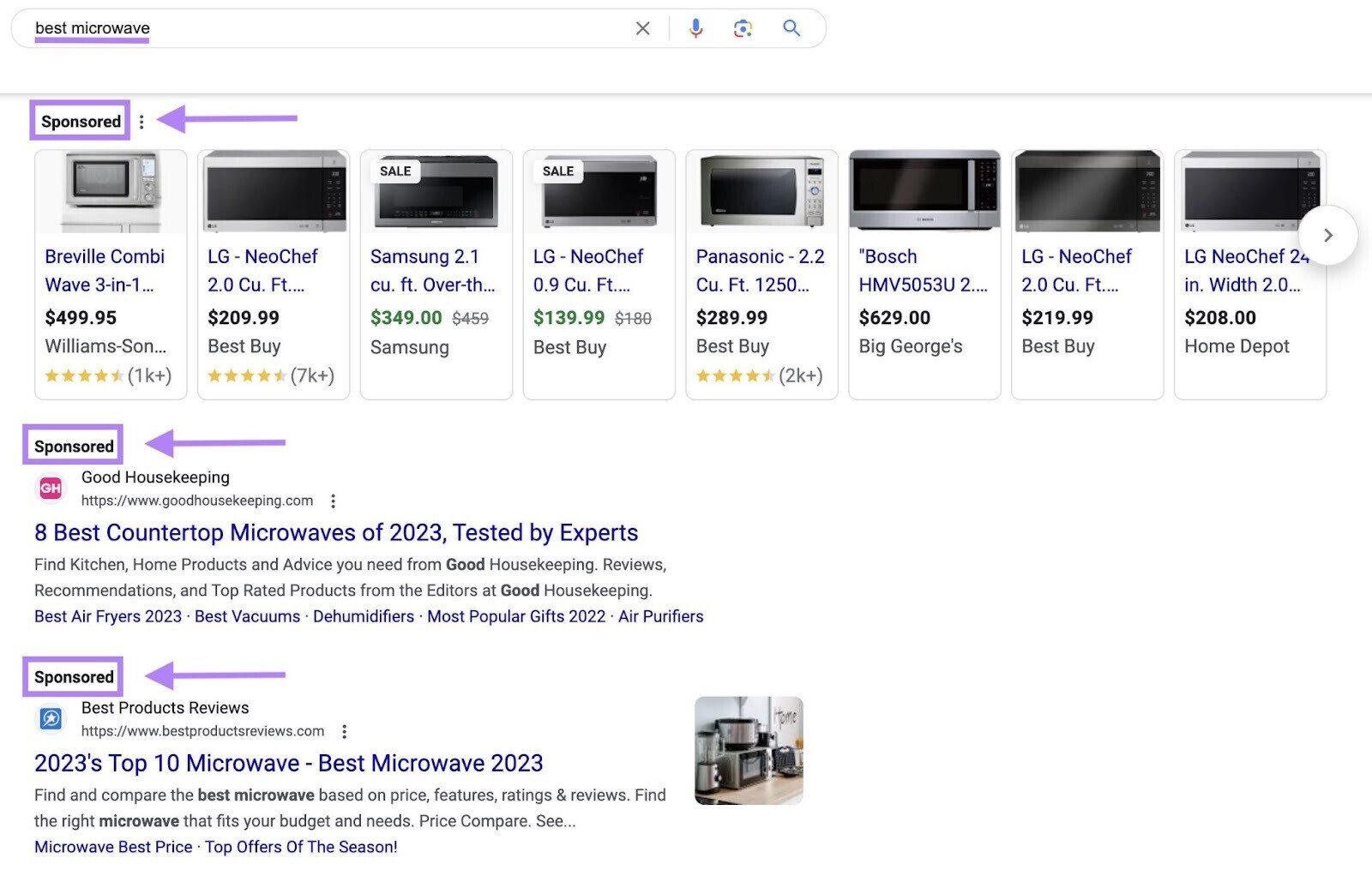
To gain the top paid search spot, businesses bid on specific keywords by setting the maximum amount they’re willing to pay any time someone clicks their ad.
Google uses many factors to determine Ad Rank and placement in the SERPs, which you can read about here.
Shopping ads also showcase products directly in the SERPs using images, giving customers a glimpse of the product before they click on the ad.
Use tools like Google for Retail to share product listings, connect with shoppers, and create PPC ads.
With a Merchant Center account, you can list your business on Google for free, get personalized insights, and boost sales. You can also link to ecommerce platforms like Shopify.
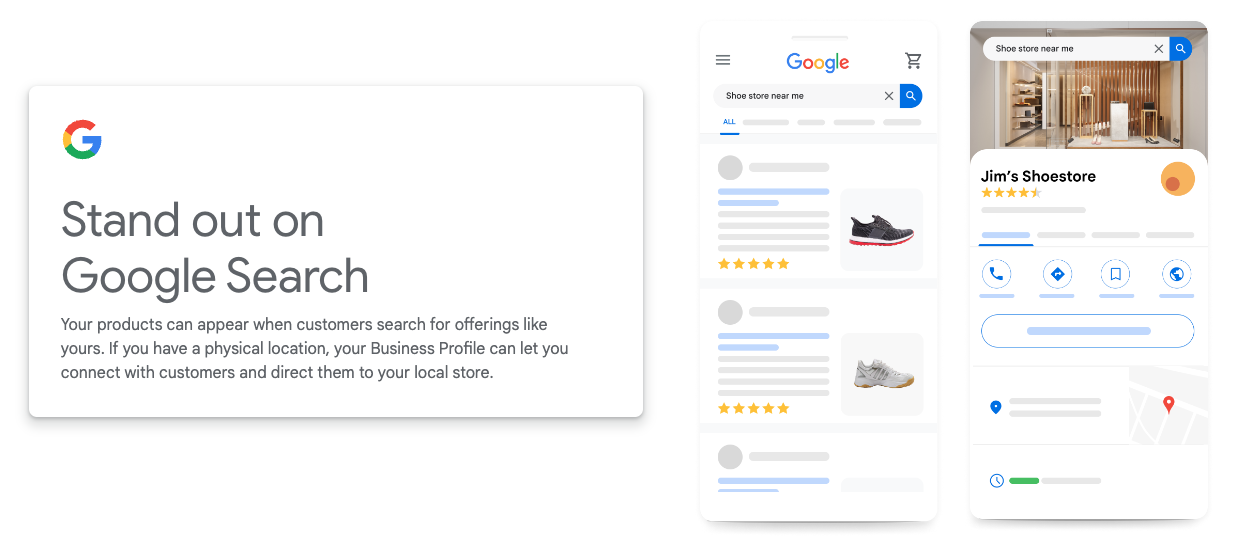
Finally, goal-based Performance Max campaigns allow you to track and reach conversion goals.
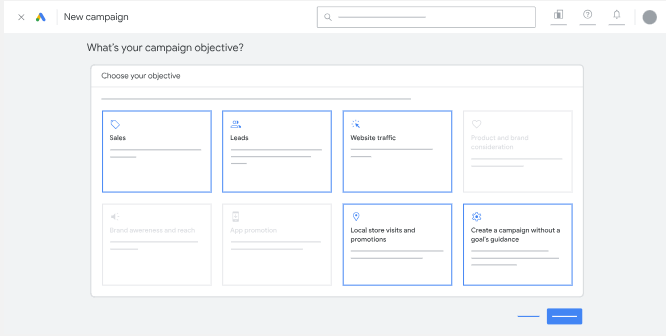
Each of these tools will help you succeed in ecommerce marketing.
Local
Ecommerce businesses can target a concentrated area by implementing local marketing tactics.
For example, a fashion retailer could use local marketing to promote a flash sale on winter coats to customers in colder regions.
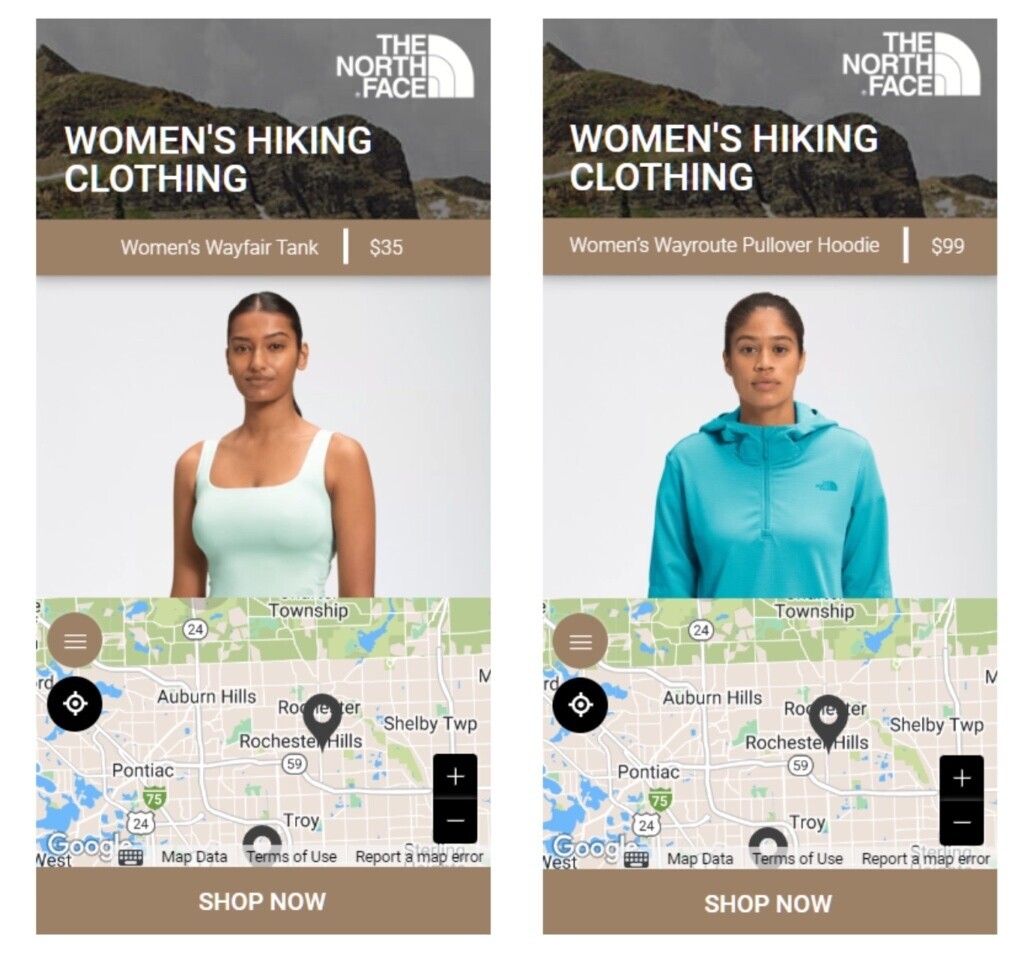
The North Face used weather-based targeting in their women's hiking ads, displaying different versions based on the weather conditions in the viewer's region.
Users in colder regions saw the pullover hoodie ad, while users in warmer regions saw the tank top ad.
Local ecommerce marketing uses strategies like website optimization, tools like Google Business Profile, local citations, backlinks, and positive reviews.
Google's local search algorithm ranks the business's relevance, distance, and prominence in search results.
26 Successful Ecommerce Strategies to Get You Results
Ecommerce marketing drives new and repeat customers through tailored campaigns that you can implement using appropriate tools. Regardless of the size of your business.
Here are 25 ecommerce marketing strategies to help you, organized by type.
Email Marketing Strategies
1. Nurture Email Leads
Despite the rise of social media and other digital channels, email marketing still has the potential to increase a business’ bottom line significantly.
Diana Carter, founder of Carter House Copy, saw a return of over $1,000 for a client from a single email campaign.
Implementing intentional and strategic tactics can help businesses create email campaigns that engage and convert audiences.
Almost 60% of consumers say marketing emails influence their purchase decisions, so this platform has significant potential to drive ecommerce sales and grow your customer base.
Platforms like Mailchimp, Constant Contact, and Campaign Monitor provide you with tools to design, send, and track your campaigns. A CRM (customer relationship management) software platform like Salesforce, Pipedrive, or Hubspot can also help you manage customer data, track lead interactions, and create targeted email campaigns.
2. Customize Your Email Campaigns
Email marketing campaigns encourage direct contact between your company and its clientele. Customized emails provide a more personal reach than social media.
Several methods can help improve your odds and increase audience engagement, including:
- Welcome emails: Let new customers know the benefits of subscribing
- Newsletter emails: Adding a personalized touch with updates can improve website traffic
- Thank you emails: Since customers are likely checking for emails from you after a purchase, this is an ideal way to promote offers
- Promotional emails and gifts: Show your customers what they could buy and sweeten the deal with a discount
- Birthday emails: Add a personal touch to any gift or special offer
- Abandoned cart emails: Send to customers who left items in their online shopping carts without completing their purchases
- Referral emails: Send to existing customers to encourage them to refer their friends or family in exchange for a reward or to join a customer loyalty program
- Shopping cart drop-out emails: Remind customers what they could have while also adding information on related products and offers
For example, in this promotional email, Uncle Jack’s offered customers a “Christmas in July” discount for ugly Christmas sweaters:
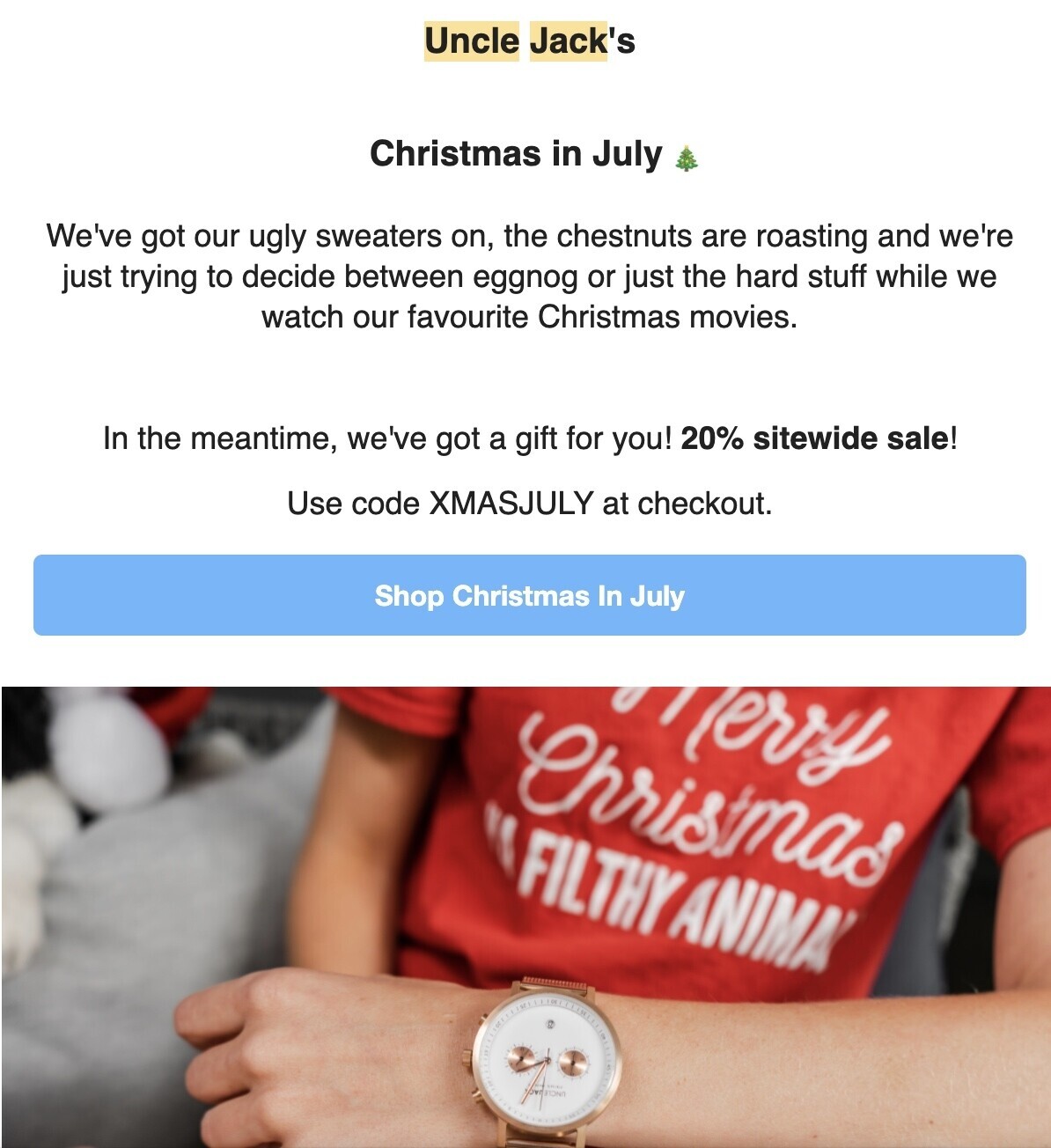
Providing personalized content and offers helps businesses foster relationships with current customers and drive online sales growth.
3. Exercise caution with hypersegmentation
Segmented email campaigns have a 100.95% higher click rate than non-segmented ones, making them the cream of the email marketing strategy.
Hypersegmentation takes it further by creating different campaigns for different segments.
While hypersegmentation may result in even higher engagement metrics, such as click-through rates, it’s not right for every business.
For smaller audiences and teams, hypersegmentation may not be the best use of resources and may result in lower revenue.
Kasey Luck, Founder of Luck & Co, urges marketers to consider:
- your audience size
- the resources you’ll put into segmentation
Small businesses with limited resources should consider hypersegmentation’s ROI carefully.
Suppose you have two marketers responsible for an email list of 20,000 people. Hypersegmenting every email campaign could mean you only reach a segment of 4–500 people.
While you may achieve a 5–10% click-through rate, your total revenue from these campaigns may be lower than if you sent emails to a wider audience.
Instead, smaller teams should focus on traditional email segmentation and put additional resources toward other marketing campaign goals.
4. Capture more email subscribers with strategic pop-ups
Email pop-ups don’t capture visitors like other methods, but they can still work.
One study of 80,000 businesses found that pop-up forms had a 2-3 % conversion rate.
Since some pop-ups intrude on the user experience, ecommerce marketers should try tactics like:
- Displaying pop-ups at the end of a blog post: Works like a CTA, triggering when users finish reading the content
- Offering a pop-up when a user is about to exit: Triggers when someone is about to close or leave the browser tab. OptinMonster offers the Exit Intent feature
- Introducing a request after a page scroll: As soon as someone scrolls down X% of a page, the subscribe box slides in from a corner
Always consider the user experience by limiting interruptions to browsing.
Social Media Marketing Strategies
5. Add shopping profiles
The Influencer Marketing Factory found that 40% of people prefer online shopping, while only 13% prefer in-store shopping.
With more people using social media to discover and buy products, social media platforms are adding shopping features.
TikTok recently introduced a feature allowing brands to add links to products in videos. Users can click on the link to buy the product without leaving the app, offering a frictionless purchase process.
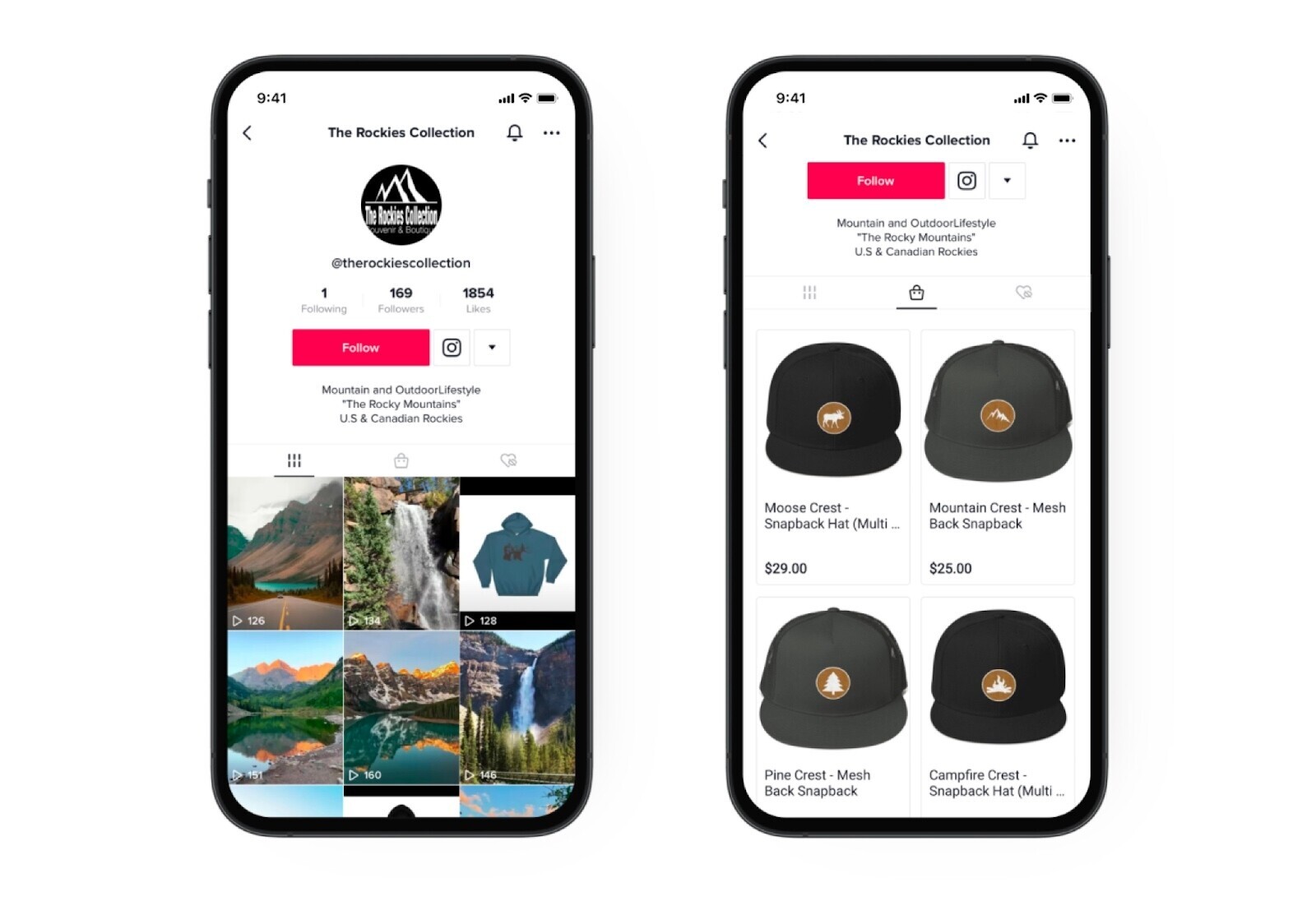
6. Lean into user-generated content (UGC)
UGC is any content created by unpaid contributors or fans of a brand, product, or service. For example, when a person posts photos or videos on social media using your product and tags your brand.
UGC can add social proof by showing how real people benefit from your products or services. Consumers are 2.4 times more likely to say UGC is authentic compared to brand-created content.
That can translate to more sales.
Modcloth, an online retailer, has a #MyModCloth section on its homepage featuring customers wearing and styling their items in real-life situations.
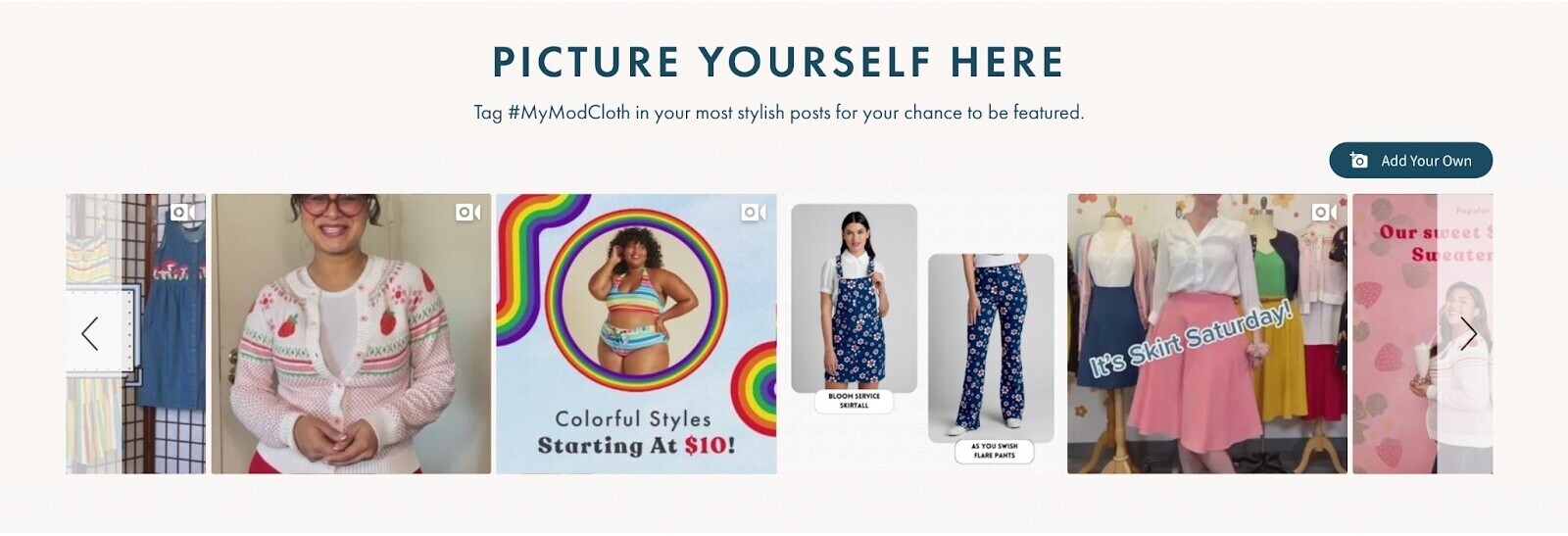
Modcloth incentivizes people to post outfits on their social profiles.
7. Collaborate with influencers
Influencers on social media can help promote your products or services while using their following and credibility to reach new customers and increase brand awareness.
You pay them to promote products through incentives like free products, lifetime discounts, and fees.
Hubspot found that 1 in 4 marketers currently use influencer marketing, with 72% of Gen Z and Millennials following them on social media.
Here’s an example of a sponsored post on Instagram:
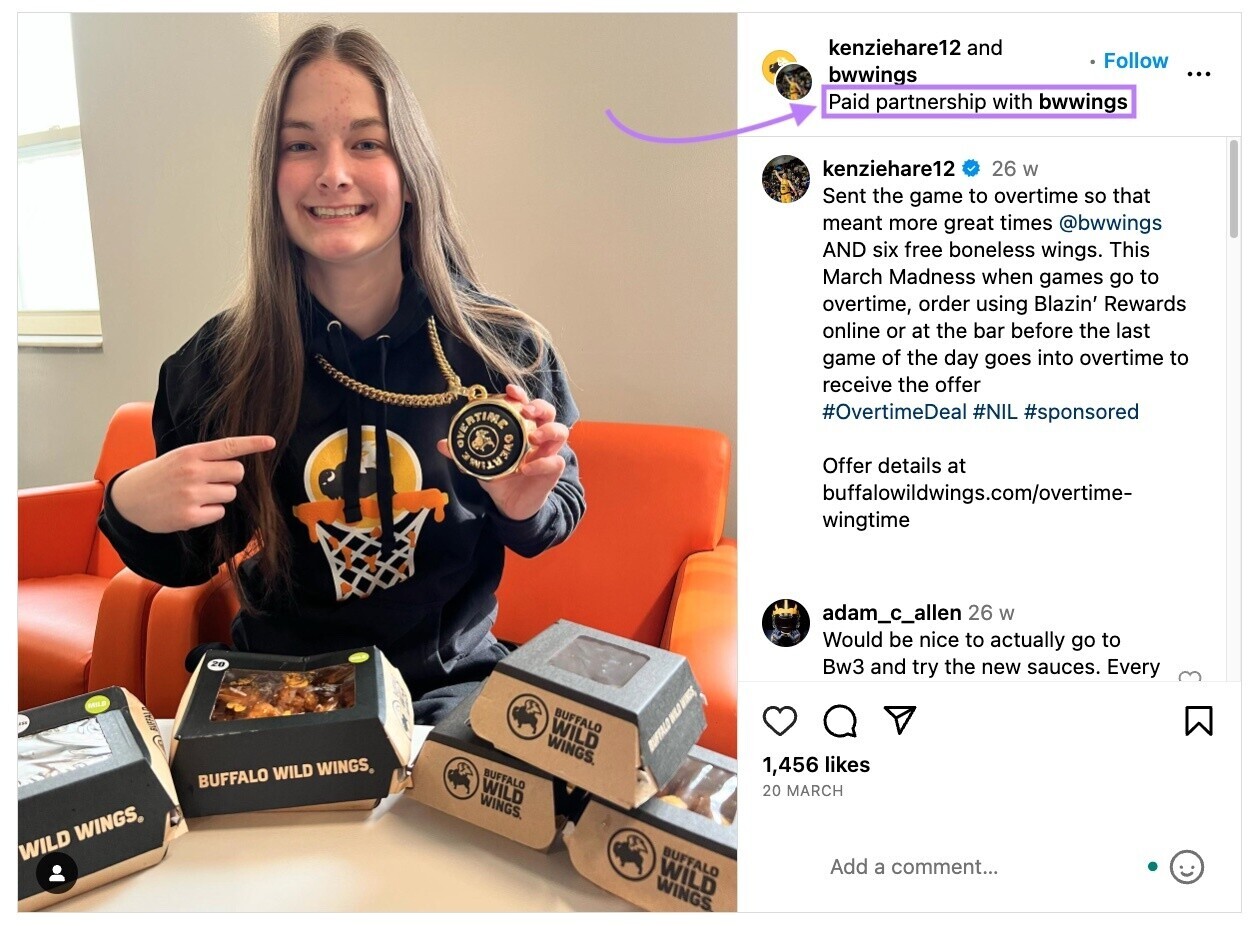
And with more in-app shopping features on popular channels like Instagram and TikTok, users can buy directly from the app, simplifying the purchase process and encouraging them to stay on your profile.
8. Host live and virtual events
Live and virtual events offer a more personal and interactive experience, allowing businesses to connect with their customers in new ways.
You can use them to:
- Showcase new products or features
- Demonstrate how products work
- Collaborate with influencers
- Answer customer questions in real time
Live and virtual events also create a sense of exclusivity and community among customers, which helps build loyalty to your brand.
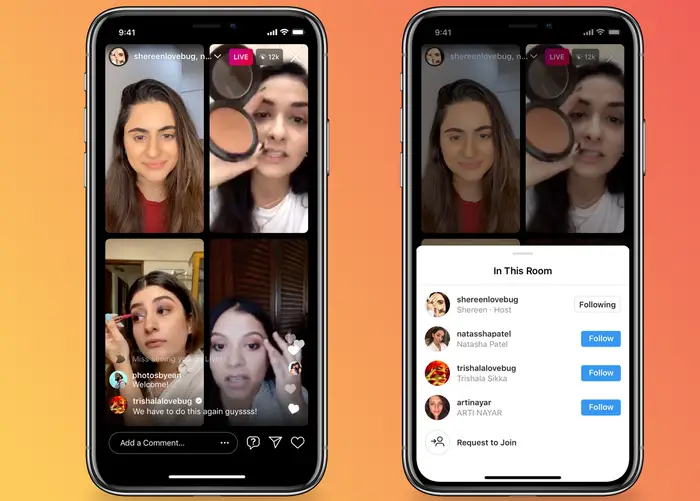
Content Marketing Strategies
9. Use video marketing
Video marketing is an engaging and memorable way for audiences to connect to your brand and better understand your product offerings. You can also use video marketing for PPC campaigns.
Google found relevant video ads get three times more attention than generic ones.
Consider using video marketing to teach about your product or services. Because 7 in 10 people feel empowered, motivated, or confident after learning something new from a Youtube video.
For example, Nespresso made this video to market its new Pixie coffee machine:
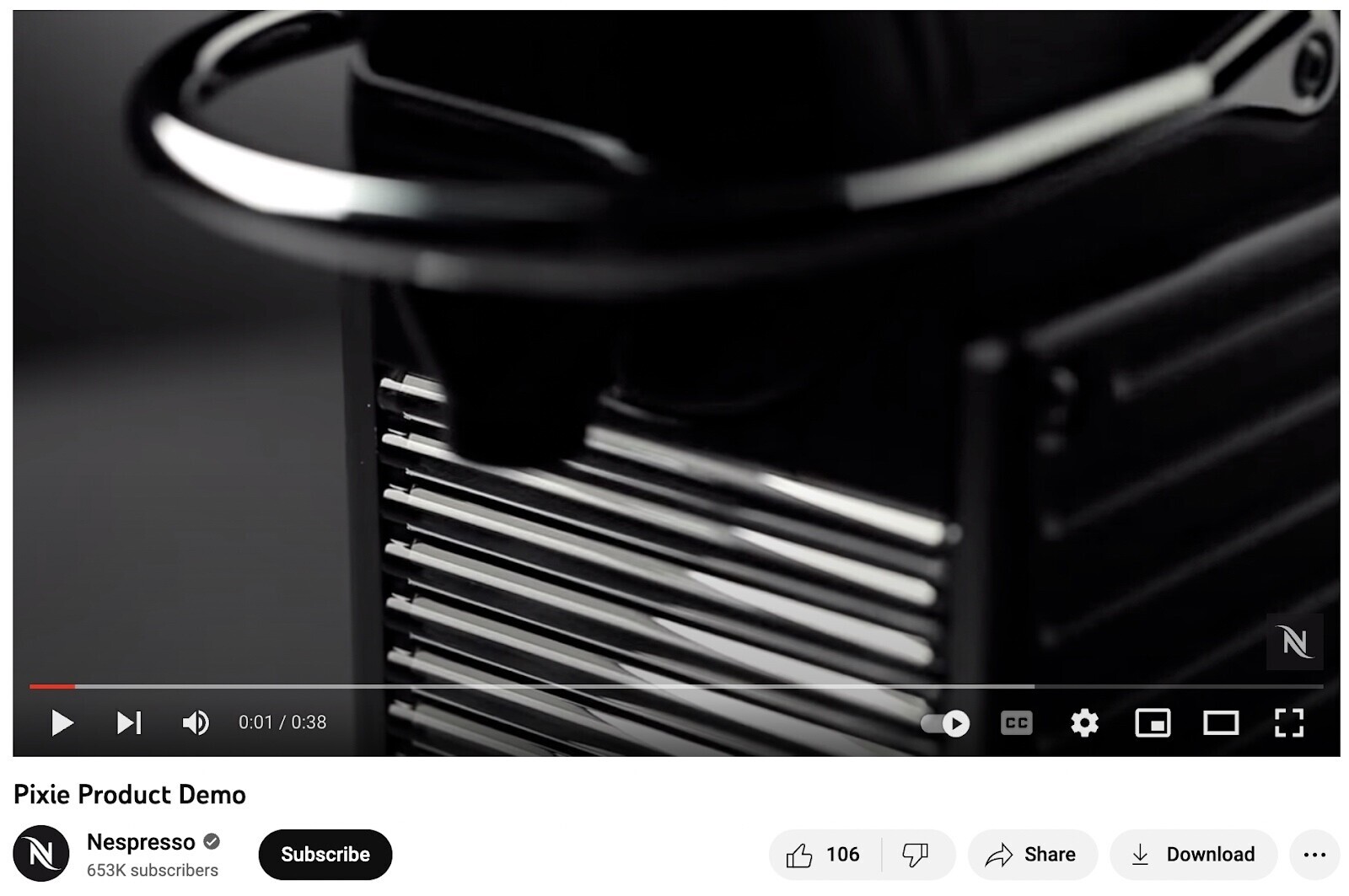
Video marketing helps establish your brand as an expert, so you can become the leading authority in your ecommerce industry.
10. Collaborate with guest bloggers
Partnering with guest bloggers drives traffic to your website and can further establish your brand as an authority in your ecommerce industry.
It works like this:
First, find bloggers with an audience interested in your niche or products through Google searches or social media platforms.
Then, reach out to them with a pitch for a guest post. For example, a formalwear brand could feature a blog about Kentucky Derby fashion in the beginning of May.
You can flesh out details like topic, deadline, and compensation. Then provide the blogger with your brand’s editorial guidelines and tone of voice.
Also, allow them to include a link to their website or social media profile in their author bio.
Once the post goes up, promote it on your social media channels and newsletter to increase visibility.
Then rinse and repeat to keep your blog fresh and attract new readers.
Collaborating with guest bloggers also gives valuable backlinks to your website. Backlinks from authoritative pages are a vote of confidence, signaling to search engines that you have valuable content. They’re also a ranking factor.
Tools like Semrush’s Backlink Analytics can help you evaluate and compare link profiles between you and your competitors.
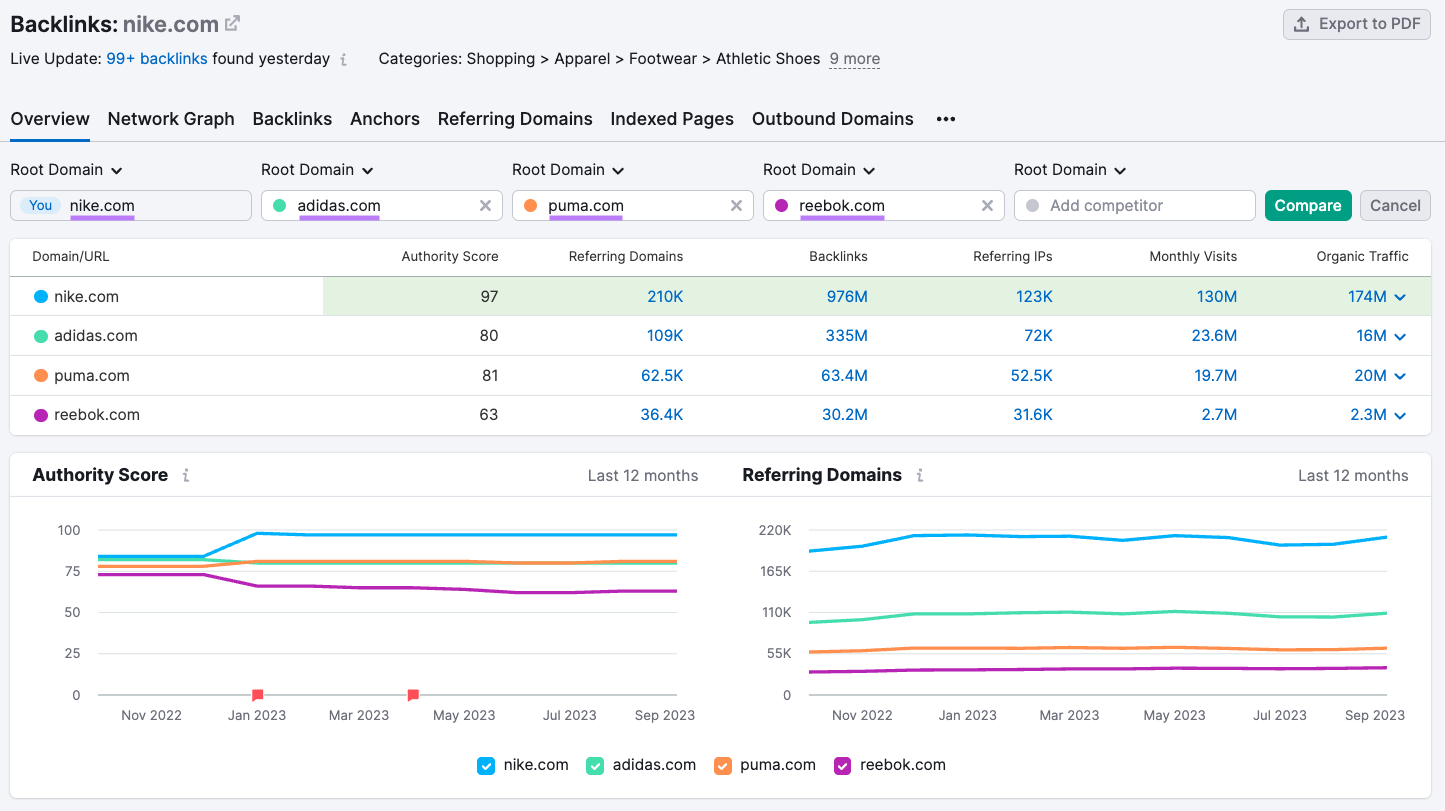
Cart Recovery Strategies
11. Prevent Out-of-Stock Inventory
Out-of-stock inventory can lead to lost sales and unhappy customers.
According to data from Statista, 58% of online shoppers in the United States felt that out-of-stock issues impacted their shopping behaviors.
One way to prevent out-of-stock inventory is to use inventory management software like ShipBob or Zoho. They help businesses track inventory levels in real time. This way, you can identify when your products run low and reorder them before they run out of stock.
Another strategy is to use an app like Back in Stock for Shopify. These apps notify customers when out-of-stock products become available.
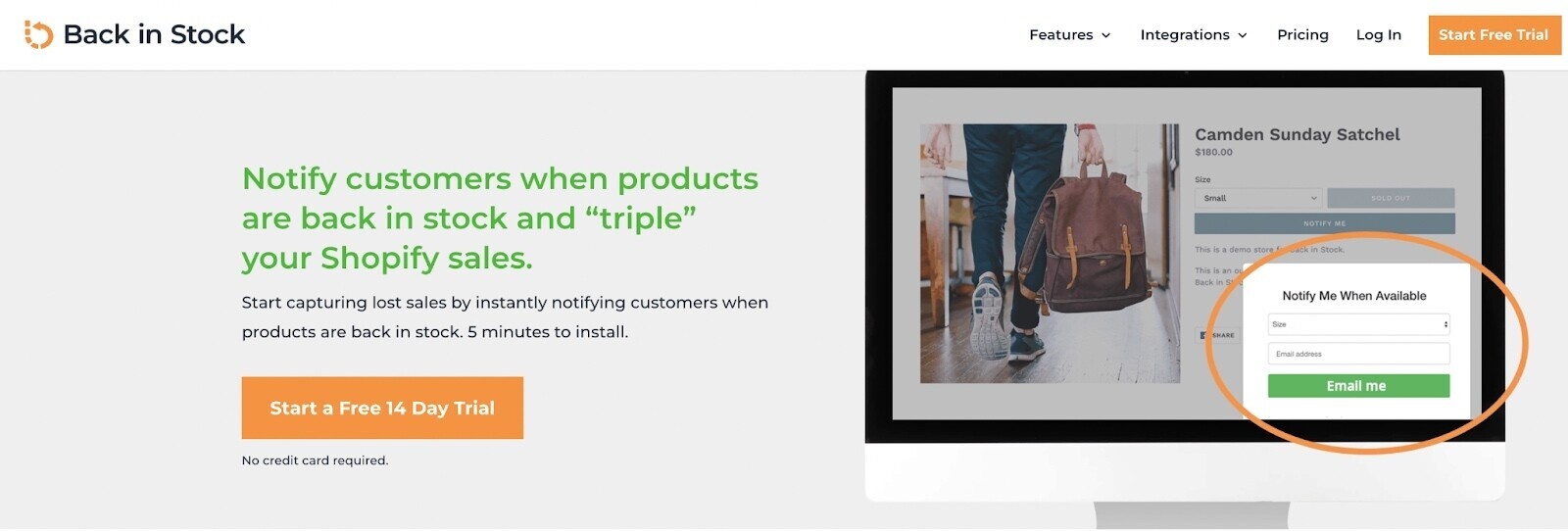
12. Abandoned Cart Messaging
Common advice is to send your first message within 30 minutes of the cart abandonment.
But James Laurain, Head of Growth at Aampe Marketing, researched the probability of purchase and found that sending a message pointing to a specific item (blue dotted line) was more effective than most other strategies.
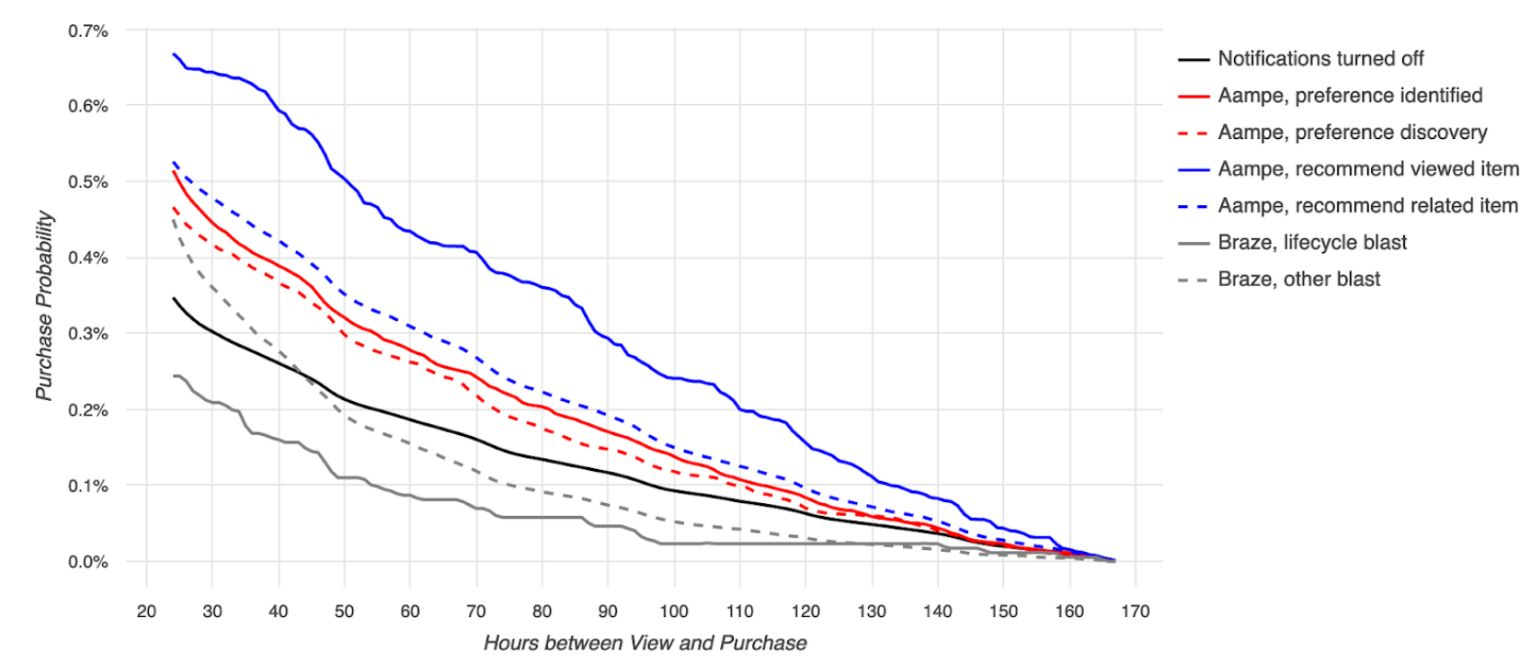
He also found that abandoned cart messages converted a full 3.5 days after customers viewed a product by optimizing the timing and messaging.
The key is finding out when someone is most likely to respond, which requires testing and refining your messaging strategies over time.
Pay-Per-Click Strategies
13. Run PPC campaigns
A survey conducted by the Out of Home Advertising Association of America (OAAA) found that the primary action taken by internet users after seeing an ad was looking for information on a search engine.
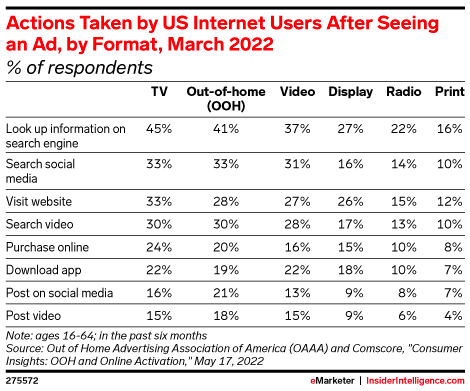
That gives marketers an opportunity to optimize their digital marketing campaigns with targeted search engine ads.
PPC ads enable you to customize the ad's message and the audience. By targeting specific demographics and interests to ensure you show your ads to the right people at the right time.
For example, a luxury watch business can create a PPC campaign targeting individuals interested in high-end timepieces who recently searched for related keywords or visited similar websites.
Using targeting options like geographic location, age, gender, and even device type, the business can ensure its ads display to the right people at the right time.
14. Retarget your customers
Retargeting involves showing ads to people who have already interacted with your business.
The idea is these customers are more likely to buy because they’re familiar with your brand and products.
Use social media platform ads on Facebook and Instagram to target audiences based on their interests, behaviors, and demographics.
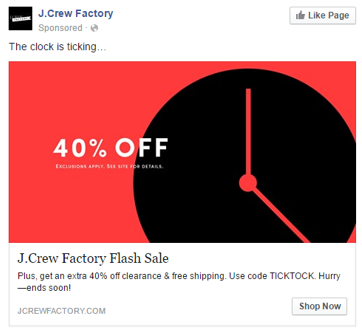
Businesses can also retarget through Google Ads and other search engines. By targeting users who previously searched for relevant keywords or visited specific pages on the website, they have a better chance of converting these potential customers.
Website Optimization Strategies
15. Show inventory on your product pages
One way to create urgency and provide useful information to your customers is to display an item’s stock levels if they are in high demand or close to selling out.
This tactic can also combat cart abandonment by creating a sense of scarcity and prompting customers to make a quick decision.
J Crew displays stock levels when products are close to selling out.
This feature isn’t distracting. What’s more, it provides extra motivation for customers to complete the purchase.
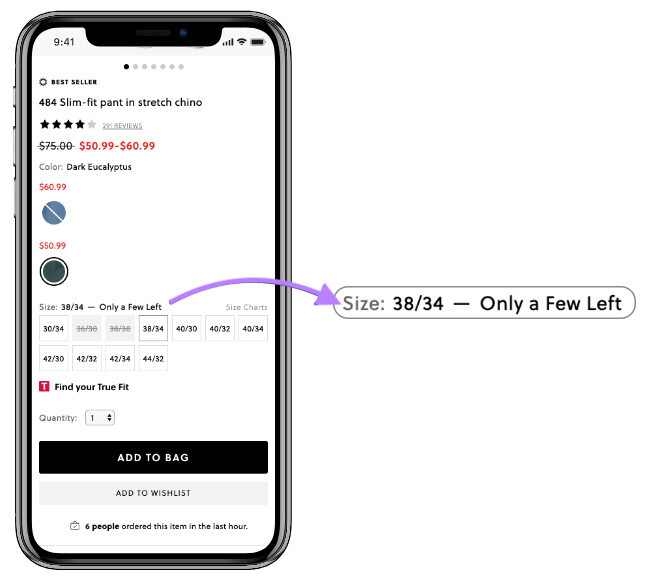
You can also use this tactic on your cart page as a final nudge to customers.
16. Use chatbots for sale promotion
Using chatbots and live chat makes your product more personalized and engaging. Tidio found that 62% of consumers would rather talk to a chatbot than a human agent.
Most chatbot services can store general information about users, like their names and email addresses. That can help your ecommerce storeretarget customers.
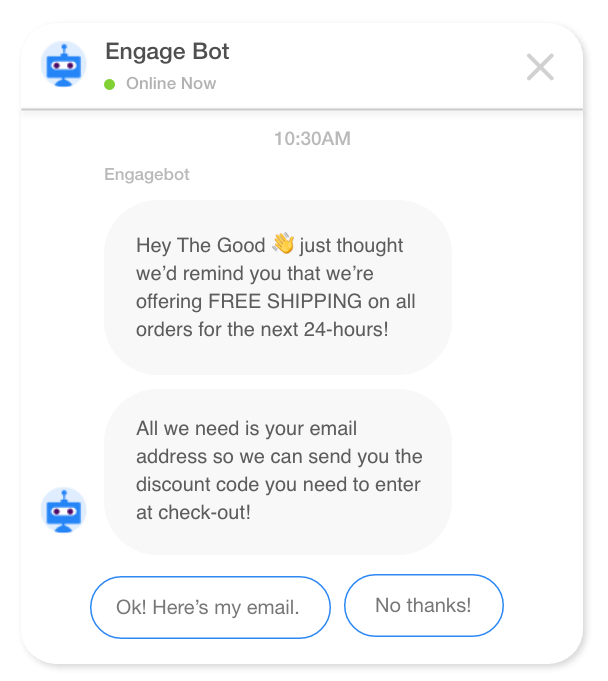
Integrating chatbots into your support strategy can enhance customer satisfaction and improve your marketing efforts.
17. Show your customers other interested users
Scarcity drives demand.
Demonstrating how many other users are interested in the same product can influence customer perception of the product’s value.
It also creates a sense of urgency to drive them toward a purchase.
Clothing brand Madewell displays how many people added the item to their bag in the last seven days, which helps add value to the product and motivates buyers.
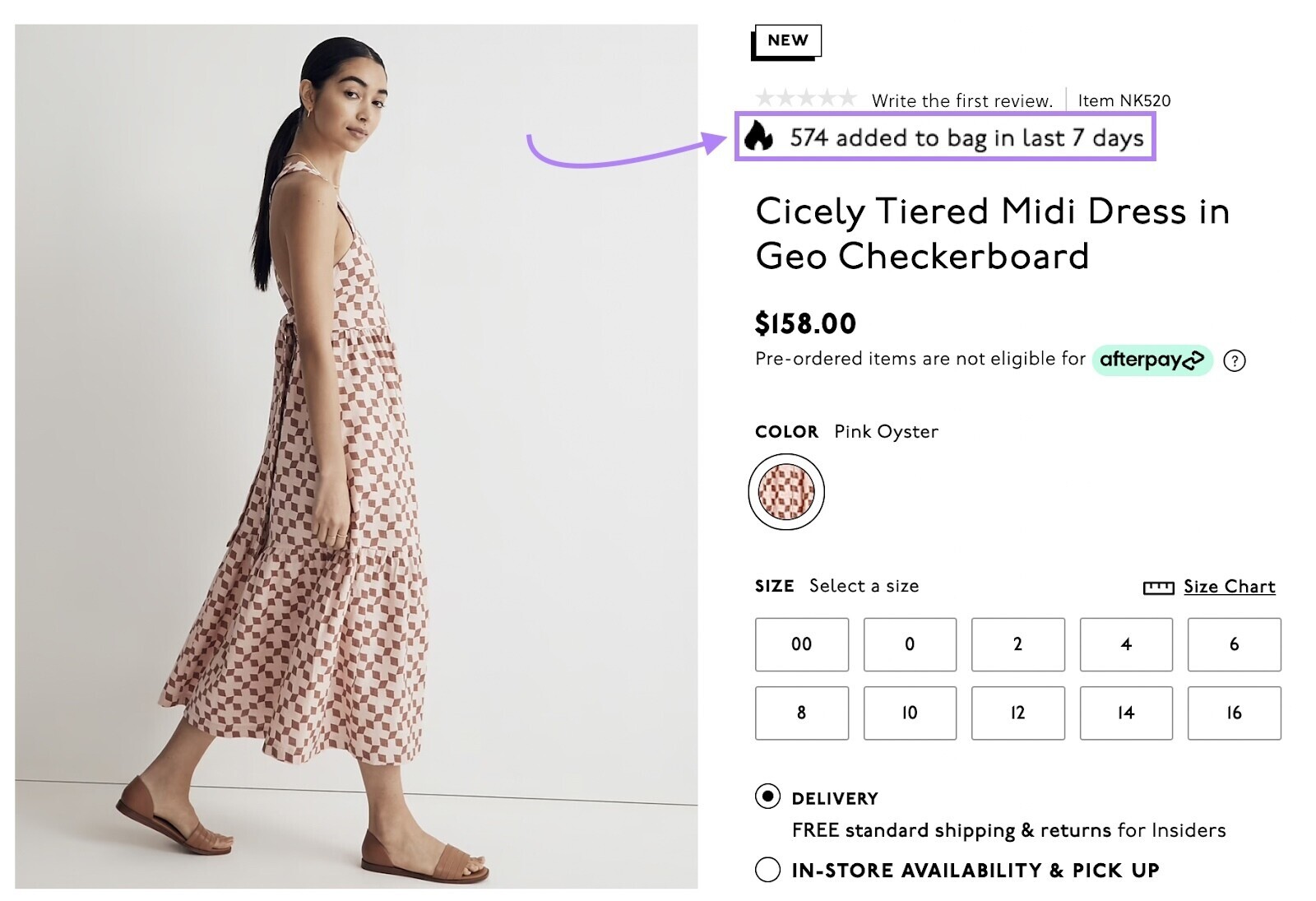
18. Write product descriptions from the customer’s point of view
Successful product descriptions speak to the customer’s needs, pain points, and concerns.
When writing descriptions, focus on your product’s benefits and how it can motivate a change in customer behavior.
Glossier balances its product descriptions by providing detailed information while also speaking the language of its customers.
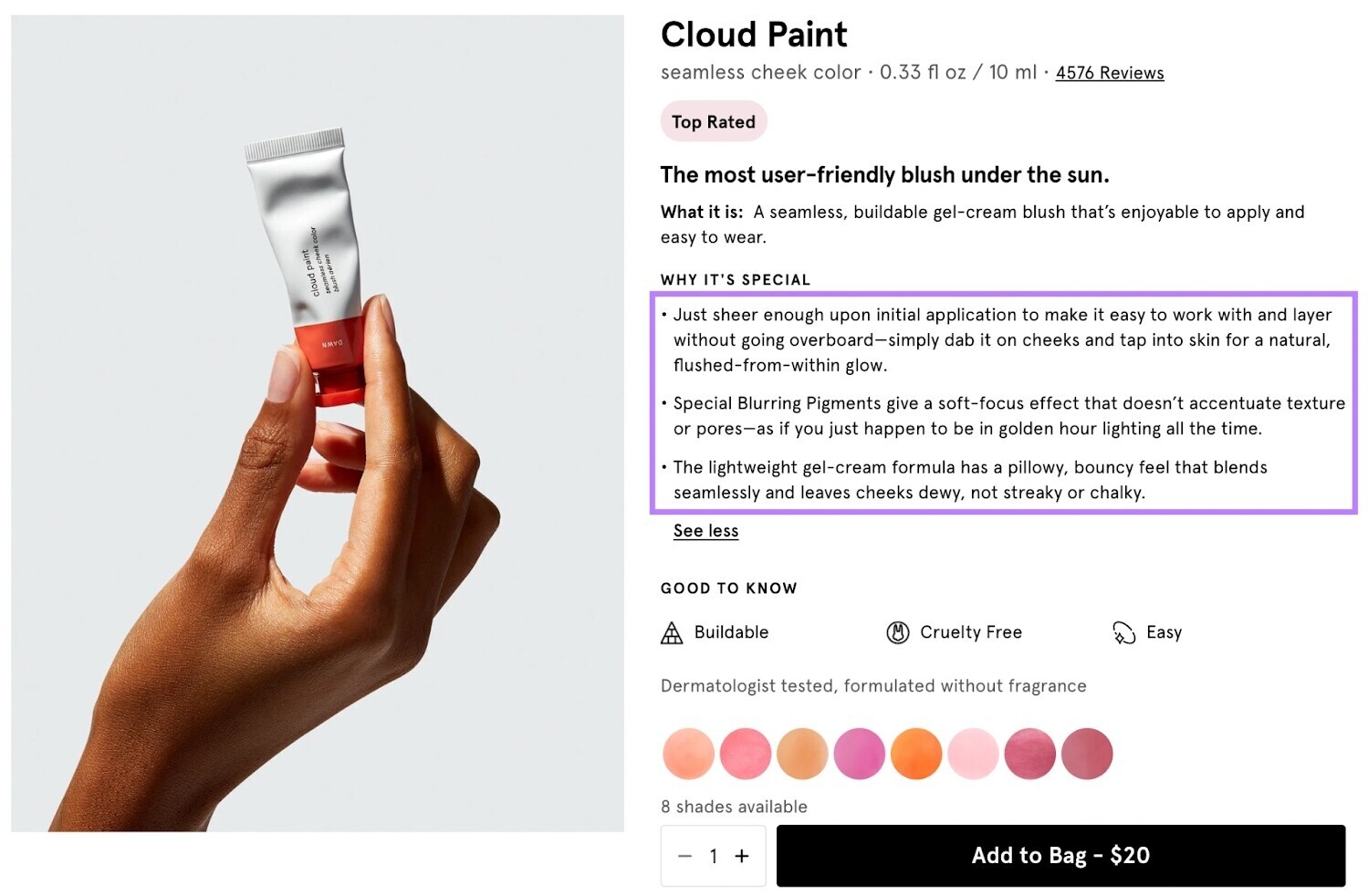
Read reviews of your products to see how customers talk about them. If common questions occur in the comments, address them in the description.
19. Feature similar products
Offering your customers alternative products to the one they’re viewing can encourage them to continue interacting and engaging with your ecommerce website.
That’s preferable to them seeking out competitors for comparison shopping.
The Good, a conversion rate optimization company, calls this “The Etsy Test.” Etsy displays similar products above the fold of the product a customer is viewing.
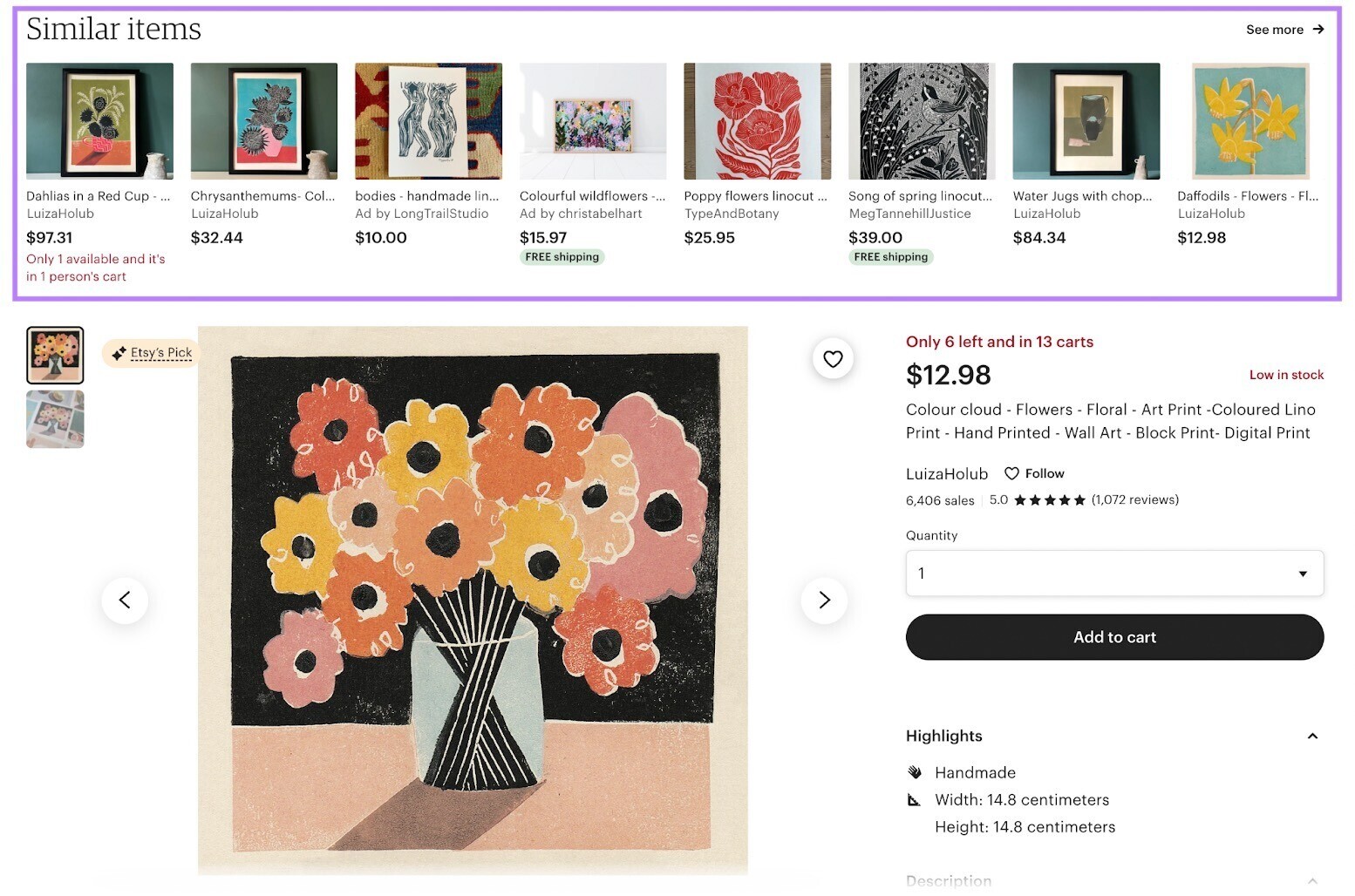
Notice how they add the number of items left in the cart to demonstrate additional scarcity.
This tactic is especially effective for brands that run Google Shopping ads because people who land on a site from a Google listing may be comparison shopping.
Adding a “Similar Items” section encourages shoppers to stay on your site even if the product they found isn’t quite right for their needs.
20. Cross-sell or upsell
Showing complementary products or add-ons is a great way to keep shoppers returning.
The probability of selling a product to an existing customer is 60–70%, while the probability of selling to a new customer is 5–20%.
Also, cross-selling accounts for 35% of Amazon’s revenue, showing it’s a highly effective sales technique.
You can cross-sell and upsell at three key points in the sales funnel:
- Before purchase: Add cross-sells and upsells on the product page before customers add an item to their cart
- During purchase: Add cross-sells and upsells during checkout or when customers view their cart
- After purchase: Send cross-sells and upsells through email, SMS, or when a customer returns to your store after a purchase
One strategy is to offer product bundles that expose customers to new products. By grouping smaller, complementary products, shoppers may be willing to pay more because they also receive more.
Madewell adds a “You Might Also Love” section to its product pages to show items that complement one another (like an outfit) and encourage bundling.

SEO Strategies
21. Optimize page titles and meta descriptions
The page title and meta description are usually the first elements users see when they search for a keyword. They may determine whether or not users click or skip your page.
We recommend following these recommendations:
- Keep your page title between 30–60 characters so people can see the full title
- Keep your meta description to 160 characters or fewer
- Include your target keyword in the title
- Use search intent to find the top-ranking titles and write your title based on these
- Communicate what readers will learn on your page
In this example, Outbrain uses a clear SEO title and meta description that shows readers what they’ll learn if they click on the article.

Tools like Semrush’s Topic Research tool help you look up successful headlines that searchers click on related to your topic.
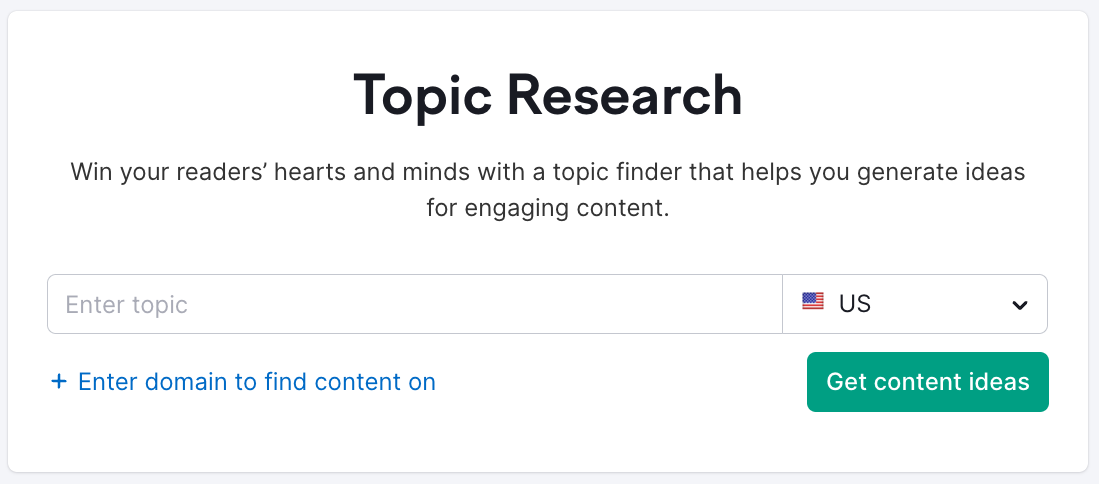
Read more about how to write effective meta descriptions to get people to click on your page.
22. Use internal and external links
Internal and external links can improve the SEO performance of your website.
Internal linking helps establish a page hierarchy on your website, indicating which pages are most important and relevant to search engines.
For example, hyperlinking text to a blog post helps your audience find related content and encourages them to stay on your site.
External links lead readers to high-quality, authoritative content on another website. When you add external links, make sure the links open in another tab so people can explore without losing their place in your content.
Read more about how to build an effective internal linking strategy and some of our best external linking practices.
23. Conduct regular site-wide audits
Audits can uncover overlooked issues like broken links, orphaned pages, or slow load times so you can address them without harming the user experience.
Semrush’s Site Audit Tool lets you conduct comprehensive site audits quickly, identifying and addressing any issues impacting your website's performance.
First, create a project and set up the audit. This article will guide you through the steps.
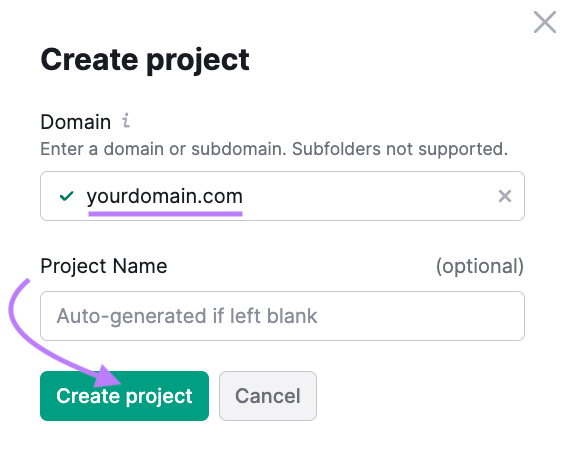
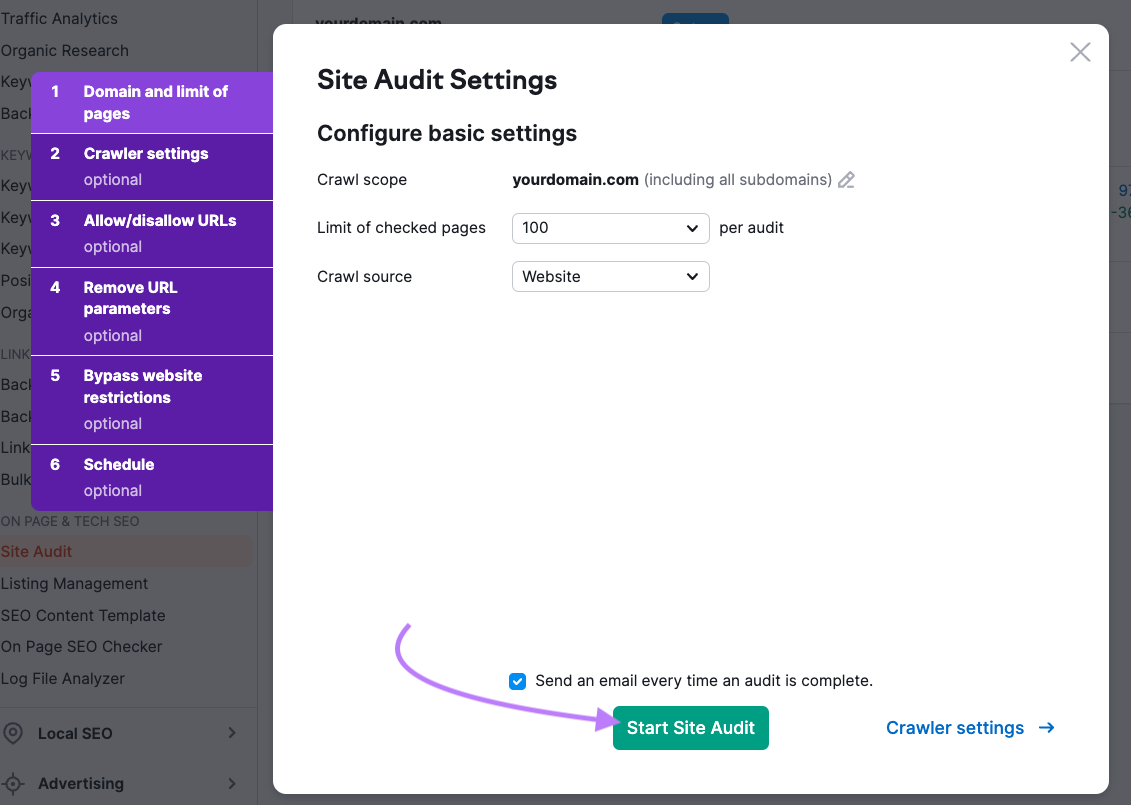
Once the audit is complete, you’ll see issues divided into three categories: Errors, Warnings, and Notices. That will help you prioritize your fixes.
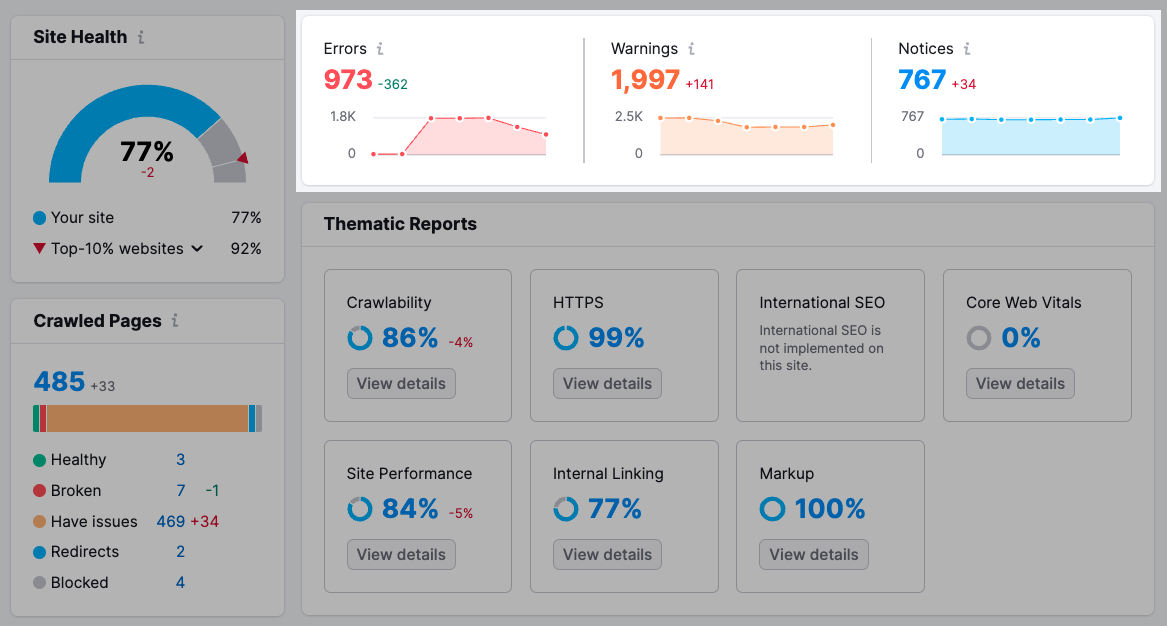
Semrush breaks out the problems by type, like crawlability, on-page SEO, or overall site performance. Some are easy to fix, while others are more complex.
Luckily, Semrush offers an explanation and “how to” guide for each problem. Just click “Why and how to fix it” next to the issue name.
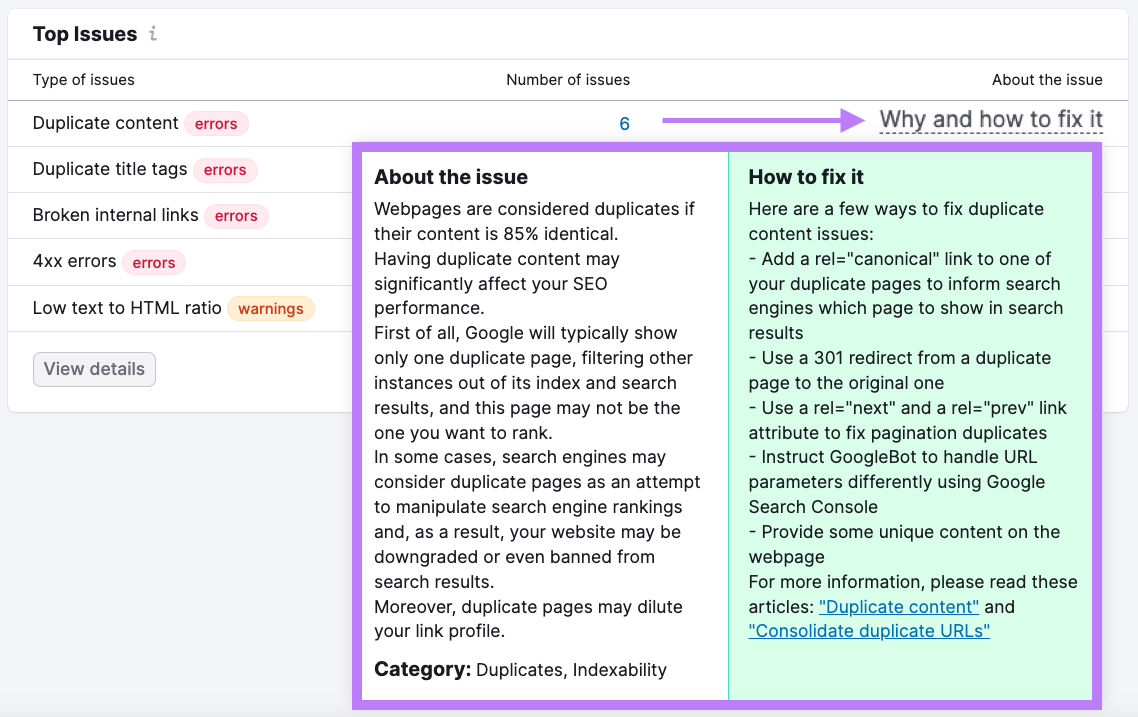
Learn more about how to conduct comprehensive SEO audits on your site.
24. Match search intent with your content
If you want users to find your content, it has to provide the exact information they want.
For example, someone searching for "how to choose the right running shoes" wants to learn more about different types of running shoes.
Someone searching for “nike pegasus running shoes” is looking to buy.
Here are some tips to help you match search intent with your content:
- Analyze search results: Look at the type of content that ranks well for the keyword you want to target and identify patterns in content format, word count, and style
- Use keywords strategically: Use the target keywords in your content, including in the title, headings, and body of the text. Avoid keyword stuffing, which can harm relevancy and the reader experience.
- Create comprehensive content: Use images, videos, and other media to enhance the user's experience and provide more value
- Optimize for readability: Use short paragraphs, bullet points, and subheadings to break up the text so it’s scannable
- Focus on user experience: Make sure it loads quickly, is mobile-friendly, and has a clear call to action
- Monitor and update: Track your content's performance in search results and update as needed. Keep an eye on changes in search algorithms through tools like Semrush’s Organic Keyword Analytics tool or Google Analytics and adjust your content strategy accordingly.
Understanding search intent helps you create relevant and useful content that meets the needs of your target audience.
25. Incorporate the primary keyword in your URL
Having a clean URL structure can help search engines understand your webpage and provide you with a more user-friendly appearance in the SERPs.
Effective URLs should:
- Use primary keywords: For example, if your primary keyword is “rollerblading gear,” you’ll want the URL to incorporate it, like example.com/rollerblading-gear
- Be legible: Separate the URL with hyphens (-) so it’s easy to read and people know what it’s about
- Use 60 characters or less: Although it’s a myth that Google prefers shorter URLs, it’s best to keep your URLs short for readability
Read more about how to structure URLs in our guide.
26. Study the competition
Analyzing your competitors’ websites can provide valuable insights into their strategies and highlight areas they may need to improve.
You can use the Market Explorer tool to track your main competitors and the Keyword Gap analyzer to compare organic keywords to your competitors.
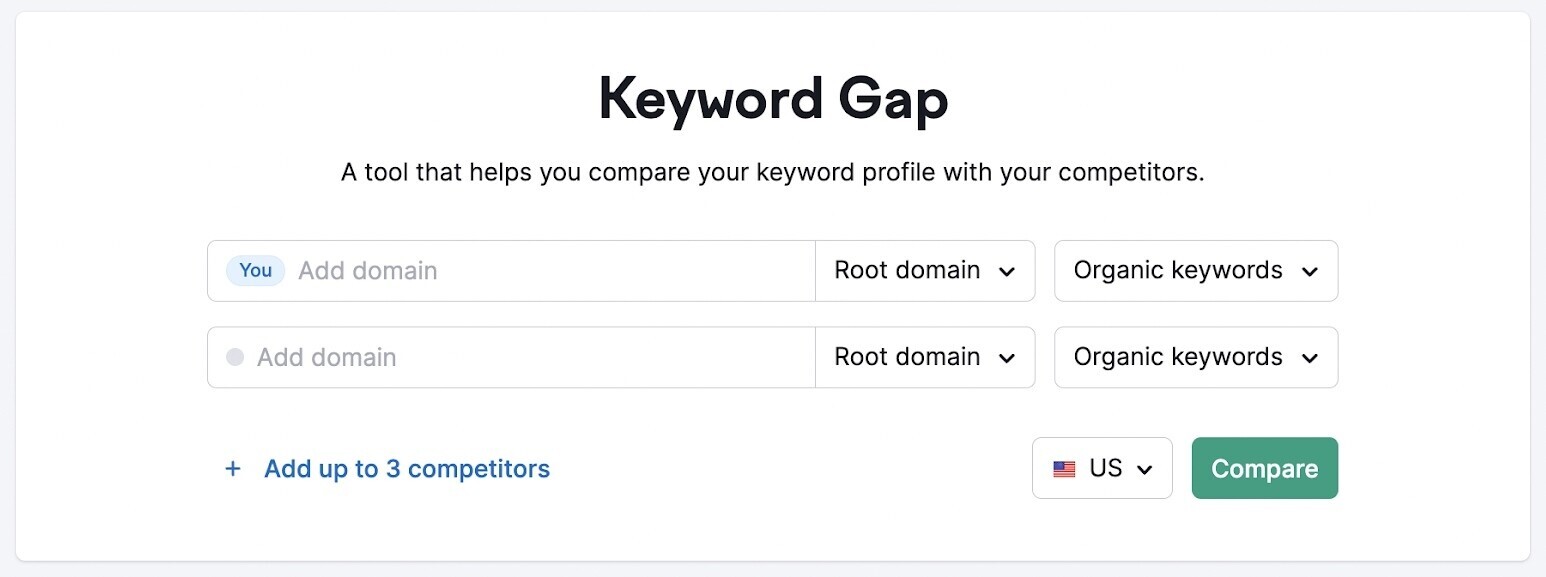
Our Traffic Analytics tool shows how much traffic your competitors receive, along with major sources and channels (e.g., paid, social, etc).
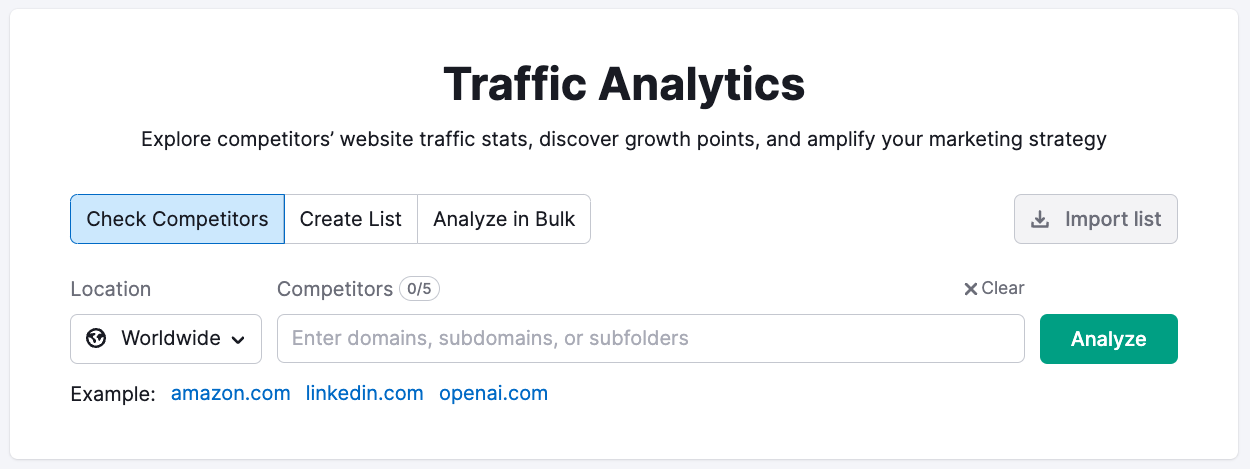
Read more about how to perform an SEO competitor analysis and gain valuable insights to improve your website’s SEO strategy.
Start Ecommerce Marketing Today
Ecommerce marketing allows you to drive traffic, sell more, and retain customers. But you need the right strategy.
With help from tools like Semrush, businesses can create effective campaigns, track performance, and optimize strategies for even greater success.
